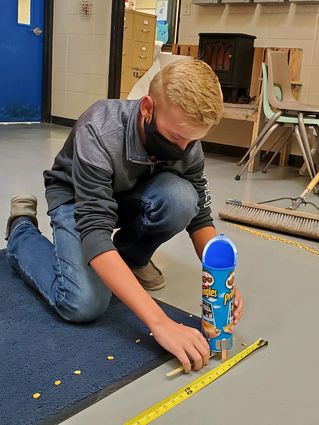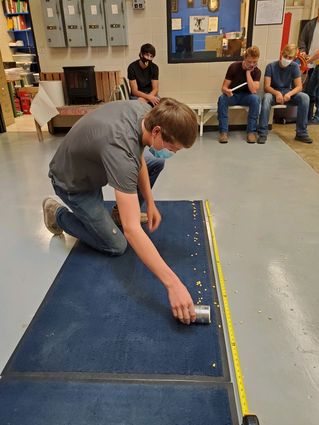Ag engineers in the making
September 3, 2020

COURTESY
Worland High School ag engineering student Baxter Crawford works on his corn-seed planter during a recent class.
WORLAND - Students in Grace Godfrey's ag mechanics class at Worland High School are learning about engineering within the agricultural field and the careers associated within that field.
Each student will be making a corn-seed planters with building criteria that the seeds need to be dispersed every two inches for a total of 60 inches. Constraints include not being able to touch the seed by hand and completing the dispersal in less than 60 seconds. Students were given the weekend to build and a day in class to test and readjust according to the "rules" before they presented their final project to the class.
BEFORE THE
PROJECT

COURTESY
Worland High School ag engineering student John Miller demonstrates his corn-seed planter in class recently.
Godfrey explained that prior to the project students learned about technological systems. Technological systems are a set of components designed to function together to accomplish a desired task. The task of agricultural systems is to produce and process food, fiber and energy. Systems in agriculture can vary from the simple to the complex. For example, a combine is a system used to harvest grain from a plant. A combine has many subsystems working together to complete that task. An internal combustion engine in the combine produces energy transferred to subsystems that cut, thresh, and separate seeds from plants. A subsystem may be a system of components by itself. The engine in the combine has subsystems tasked with producing energy.
Godfrey said, "Agricultural engineering involves designing technological systems improving how we live. Engineers use the engineering design process, which they have practiced and used in the previous course. They also apply three types of skills during the design process; mathematical, scientific and technical. Engineering disciplines are areas of study related to different scientific principles and processes. Agricultural engineers apply many of those disciplines to improve agricultural production and processing. They apply civil, mechanical, electrical, and chemical disciplines while designing agricultural systems."
A wide array of careers exist within the agricultural engineering field. Engineering requires a variety of people with multiple talents. The engineering industry includes individuals who are not engineers. While engineers may develop the design solution for meeting constraints and criteria, other professionals need to carry out the design resulting in a final product or process. Engineering technicians draft, model, troubleshoot and test a design. No design can be tested unless it is first constructed. Tradespeople have the technical skill to build the design solution. They follow the plans drafted by the technician and the criteria and constraints set by the engineer.

